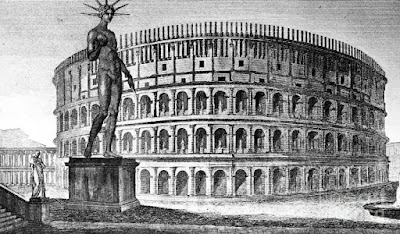"Animals both tame and wild were slain to the numbers of nine thousand"
So why is it, that this imposing and impressive building is not more widely called the Flavian Amphitheatre, but by the name it is known by all over the world, the Colosseum.
 |
| The Flavian Amphitheatre or the Colosseum? |
In AD 64 the centre of Rome was swept clear by one of the most devastating fires to ever savage the city. Fire was common in Rome, over population, timber buildings one on top of the other and a population using oil lamps for lighting, meant fire was a continual problem. Despite the popular apocryphal tale that Nero fiddled while Rome burnt, Tacitus records that he was not even in the city at the time. However Nero seized upon a "golden" opportunity when it came along.
"The report had spread that, at the very moment when Rome was aflame,
he had mounted his private stage, and typifying the ills of the present by the calamities of the past,
had sung the destruction of Troy"
The Emperor wasted no time in finally building himself a home right in the centre of the city, worthy of his stature, the Domus Aurea. His Golden House. The Golden House covered the slopes of three of Rome's seven hills, the Palatine, Esquilline and Caelian hills and is estimated to have covered an area of 300 acres. Within these grounds were groves and vineyards, fields of pasture on which flocks were kept and most imposingly an artificially dug lake.
The house itself was no less impressive, with the huge amount of gold leaf used giving the buildings its name, pools and fountains, rooms individually decorated with frescos and semi-precious stones and most famously a supposed dining room with a revolving roof from which flower petals could be showered upon its guests.
"He deigned to say nothing more in the way of approval that he was at last beginning to be housed like a human being"
As you might expect this opulence and excess didn't go down well with the people or the historians of Rome. Which is why, after the death of Nero, the chaos of civil war and the rise of the Flavian's as the new ruling dynasty of Rome, one of Vespasian's first actions was to build his temple for the people on the site of Nero's golden house.
 |
| Colossal State of Nero outside the Colosseum |
So why is it that the Flavian Amphitheatre is Nero's lasting legacy? Well, arguably its very construction was a response to the whole of Nero's "tyrannical" reign. Vespasian took the heart of the Roman's city and returned it too them. The Flavian Amphitheatre, was a visible symbol of what had been taken from them, and what had been returned.
Secondly is the very name of the building itself. Part of Nero's great Domus Aurea complex was a colossal statue of himself within the grounds, a Colossus Neronis. Originally in the vestibule to his mighty palace complex, after his death, the statue was changed with a solar crown to a statue of the god Sol.
"Its vestibule was large enough to contain a colossal statue of the emperor a hundred and twenty feet high"
Suetonius Life of Nero Chapter 31
During the reign of Emperor Hadrian, probably around AD 128, the statue was moved to just outside the Flavian Amphitheatre in order to create space for a temple. The proximity of this colossal statue to the Amphitheatre is one of the popular theory as to how the building got its nickname, the Colosseum. So, Nero's legacy lived on, even if it was in negative connotations, the Colosseum is just as much Nero's building and legacy as it was Vespasian's and the Flavians.
Thanks for Reading
James

No comments:
Post a Comment